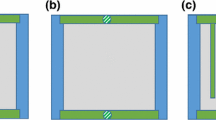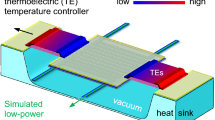Abstract
We present measurements of the thermal conductance, G, and effective time constants, \(\tau \), of three transition-edge sensors (TESs) populated in arrays operated from 80–87 mK with T\(_\mathrm{C}\) \(\sim \) 120 mK. Our TES arrays include several variations of thermal architecture enabling determination of the architecture that demonstrates the minimum noise equivalent power, the lowest \(\tau \), and the trade-offs among designs. The three TESs we report here have identical Mo/Cu bilayer thermistors and wiring structures, while the thermal architectures are: (1) a TES with straight support beams of 1 mm length, (2) a TES with meander support beams of total length 2 mm and with two phonon-filter blocks per beam, and (3) a TES with meander support beams of total length 2 mm and with six phonon-filter blocks per beam. Our wiring scheme aims to lower the thermistor normal state resistance R\(_{N}\) and increase the sharpness of the transition \(\alpha =\) dlogR/dlogT at the transition temperature T\(_\mathrm{C}\). We find an upper limit of \(\alpha \) given by (\(25\pm 10\)), and G values of 200 fW/K for (1), 15 fW/K for (2), and 10 fW/K for (3). The value of \(\alpha \) can be improved by slightly increasing the length of our thermistors.




Similar content being viewed by others
References
A.D. Beyer, P.M. Echternach, M.E. Kenyon, M.C. Runyan, B. Bumble, C.M. Bradford, J.J. Bock, W.A. Holmes, IEEE Trans. Appl. Supercond. 23, 2100104 (2013)
J.E. Sadleir, S.J. Smith, S.R. Bandler, J.A. Chervenak, J.R. Clem, Phys. Rev. Lett. 104, 047003 (2010)
J.E. Sadleir, S.J. Smith, I.K. Robinson, F.M. Finkbeiner, J.A. Chervenak, S.R. Bandler, M.E. Eckart, C.A. Kilbourne, Phys. Rev. B 84, 184502 (2011)
J.C. Mather, Appl. Opt. 21, 1125 (1982)
A.D. Beyer, M.E. Kenyon, P.M. Echternach, B.-H. Eom, J. Bueno, P.K. Day, J.J. Bock, C.M. Bradford, Proc. SPIE 7741, 774121 (2010)
K.D. Irwin, G.C. Hilton, Top. Appl. Phys. 99, 63 (2005)
D.A. Bennett, D.S. Swetz, D.R. Schmidt, J.N. Ullom, Phys. Rev. B 87, 020508 (2013)
Author information
Authors and Affiliations
Corresponding author
Rights and permissions
About this article
Cite this article
Beyer, A.D., Kenyon, M.E., Bumble, B. et al. Comparing Transition-Edge Sensor Response Times in a Modified Contact Scheme with Different Support Beams. J Low Temp Phys 176, 299–303 (2014). https://doi.org/10.1007/s10909-013-1027-y
Received:
Accepted:
Published:
Issue Date:
DOI: https://doi.org/10.1007/s10909-013-1027-y




